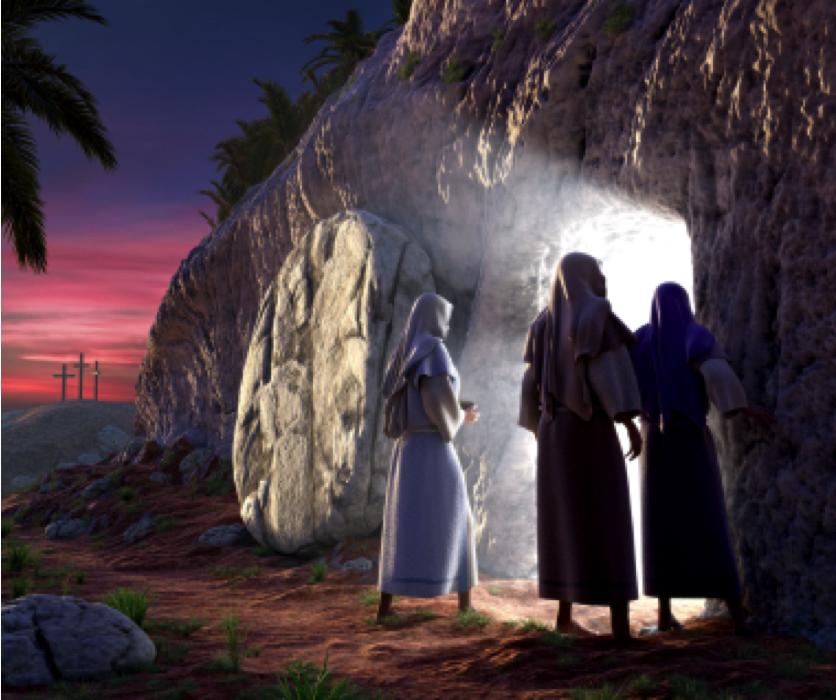SPECIAL REVELATION
We previously said that the term “revelation” can be understood in its broad sense as a “communication from God” or its narrow sense as the “disclosure of something previously unknown.”
These few segments about Jesus’ resurrection are part of what theologians call “special revelation.” This is revelation about God that is not readily apparent to the every person. We said there are three different kinds of what theologians call “special revelation”:
• The revelation of Jesus Christ
• Scripture
• Particular revelation to individuals
The most important of these is the revelation of Jesus Christ. This includes the understanding that Jesus of Nazareth was more than a good man or wise teacher: He was the Son of God. How do we know this? Well, there is reliable historical evidence for the resurrection of Jesus from the dead.
“THREE KEY ASPECTS” OF THE RESURRECTION NARRATIVE
In the last blog, we established that there are multiple sources who attest to the fact that Jesus died and was buried in Joseph of Arimathea’s tomb.
So now we would like to focus on “three key aspects” of the resurrection narrative. The question before us would be, “Is the resurrection of Jesus the best explanation for these three phenomena?”
1. The empty tomb was discovered by a group of his women followers three days after the crucifixion (Sunday).
2. There were post-mortem appearances of Jesus to various people over a 40-day period.
3. There was no existing tradition in the Jewish culture of that day about an individual being resurrected.
So we need to (1) examine how accurate these three facts are and then (2) weigh the resurrection narrative against competing theories to see if they are more plausible.
THE EMPTY TOMB
Here are six lines of evidence that establish the fact of the empty tomb:
1. THE HISTORICAL RELIABILITY OF JESUS’ BURIAL IS EVIDENCE FOR THE EMPTY TOMB.
• Everyone in Jerusalem had to have a general idea where the tomb was or would be able to find it.
• The disciples wouldn’t have believed in the resurrection if Jesus’ body was still there.
• To Jews and even pagans, the term “resurrection” definitely meant a physical, bodily resurrection.
• Even though the place of the tomb was common knowledge, the story of the resurrection spread far and wide in the city of Jerusalem where people could have looked at the tomb themselves.
• If the body were still there, Jewish authorities would have identified the disciples’ story about the resurrection as a hoax by pointing to the tomb or exhuming the body.
• It is unlikely that Christian sources would fabricate a story about a member of the Sanhedrin (the body that engineered Jesus’ murder) volunteering his tomb for Jesus’ burial.
2. THERE WERE VERY EARLY AND INDEPENDENT SOURCES REGARDING THE DISCOVERY OF JESUS’ EMPTY TOMB.
• There are grammatical ties between the burial story and the open tomb story that indicate the source that Mark used probably contained both stories as one continuous narrative.
• It is unlikely that Mark’s source would have ended with Jesus’ burial and not told the victorious ending about an open tomb and resurrection.
• When gospels used very early sources that each juxtaposed “He was buried” with “He is risen,” it implied an empty tomb.
• In Jewish culture, “buried” would mean the body or bones were buried, and “resurrection” could only mean physical or bodily resurrection as well. Anything else would not make sense to them.
• For the empty tomb to be discovered on the third day, we have evidence that is extraordinarily early and from independent sources. So the empty tomb cannot be ignored and categorized as legendary embellishment.
• Mark had an early source that he used to write his gospel.
• In Matthew 28:15 it says that this story “has been spread among Jews ‘till this day.” Matthew was quoting already existing oral tradition.
• Luke has his own source because he relates aspects of the story not found in Mark: two disciples verifying the womens’ report that the tomb was vacant. This is corroborated by John.
• John’s gospel used sources that were independent of the sources used by the synoptic gospels, but he also testified of the empty tomb.
• Historians normally are excited about having two independent sources to corroborate a historical event. However, in this case we have at least six, early, independent sources all indicating that the women discovered an empty tomb.
3. THE PHRASE “FIRST DAY OF THE WEEK” REFLECTS ANCIENT TRADITION.
• According to Mark’s gospel, the empty tomb was discovered by the women “on the first day of the week.”
• The oral tradition that Paul quoted in 1 Corinthians 15:3-5 said that they proclaimed Jesus’ resurrection “on the third day.” This was a tradition that he received within two years of Jesus’ death.
• The tradition or source that Mark used was older than Paul’s because Mark’s account reverts to the phrase that was used closest to the time of the actual event: “on the first day of the week.”
• It would be near impossible for the “empty tomb” tradition to be a late-developing legend.
4. MARK’S ACCOUNT WAS SIMPLE AND LACKED LEGENDARY DEVELOPMENT.
• Mark’s version stands out as being straightforward and lacking embellishment, one indication that it was written very early or that it was based on earlier sources.
• He does not describe the resurrection itself or reflect on Jesus’ triumph over sin, no fancy Christological titles, no quotations from prophecies that were fulfilled, no description of Jesus after he was raised from the dead.
• Compare this to the apocryphal Gospel of Peter, fakery that was not written until the second century: It describes Jesus as a gigantic figure whose head reached above the clouds, supported by giant angels, followed by a talking cross, a triumphant voice from heaven, and all this seen by a Roman guard, the Jewish leaders, and a group of spectators!
• Mark, on the other hand, was early and simple, unadorned by legend.

5. WOMEN DISCOVERED THE EMPTY TOMB.
• First, in Jewish society, women were not considered to be credible witnesses.
• Josephus quoted Moses’ rule regarding what was admissible in a court: “Let not the testimony of women be admitted, on account of the levity and boldness of their sex.” (Antiquities of the Jews IV.8.15. section 219). There is nothing about this in the Pentateuch; this was simply a reflection of first-century Judaism — something they made up.
• Second, women were simply second-class citizens in Jewish society.
• The daily prayer of every Jewish man included this benediction: “Blessed are you, Lord our God, ruler of the universe, who has not created me a woman.” (Berachos 60b)
• So it is actually amazing that it was women, whose testimony was considered to be worthless, discover the empty tomb!
• It’s possible that there is no other more powerful aspect of this story. The un-Jewish nature of crediting the women with this discovery is so against the normal practice of that day that many modern scholars are convinced of the authenticity of Mark’s account by this feature of the story.

6. THE EARLIEST JEWISH ATTACKS ON THE RESURRECTION NARRATIVE START WITH THE ASSUMPTION THAT THERE WAS AN EMPTY TOMB.
• In Matthew 28:11-15 (RSV), he identifies the Jewish leaders’ initial attempt to undermine the resurrection story:
“11 While they were going, behold, some of the guard went into the city and told the chief priests all that had taken place. 12 And when they had assembled with the elders and taken counsel, they gave a sum of money to the soldiers 13 and said, “Tell people, ‘His disciples came by night and stole him away while we were asleep.’ 14 And if this comes to the governor’s ears, we will satisfy him and keep you out of trouble.” 15 So they took the money and did as they were directed; and this story has been spread among the Jews to this day.”
• Look at the last remark: “This story has been spread among the Jews to this day.”
• Matthew wrote this because he was concerned about stopping this lie from spreading among the Jewish people.
• So the disciples were telling everyone that Jesus was resurrected. The Jewish leaders were telling everyone that the disciples stole Jesus’ body from the tomb.
• What does that mean? It means that it was obvious to everyone that the tomb was empty! No one at that time questioned that fact.
FURTHER READING
These six lines of evidence about the “empty tomb” were obtained from Dr. William Lane Craig in his book Reasonable Faith.
For further insight on the resurrection, read N.T Wright’s exhaustive study entitled The Resurrection of the Son of God.

